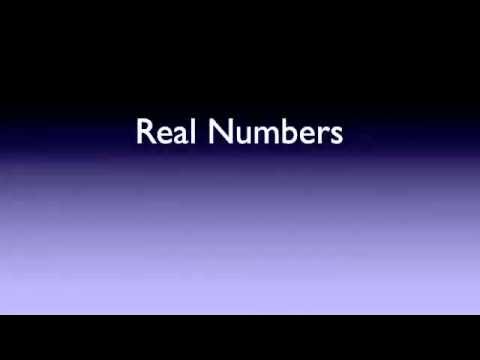Introdução ao Cálculo - u01t01
Summary
TLDRIn this introductory video on set theory, Jaqueline provides an overview of fundamental concepts in mathematics, focusing on numerical sets and their properties. She explains key sets like natural numbers, integers, rationals, irrationals, and real numbers, as well as their interrelations. The video also covers essential set theory concepts such as set membership, subsets, and set operations, including union, intersection, difference, and complement. Using Venn diagrams, Jaqueline illustrates how these sets interact, helping students understand the building blocks for further studies in calculus and mathematics.
Takeaways
- 😀 The video introduces the topic of set theory as part of an introductory calculus course.
- 😀 It begins by explaining the basic concept of numerical sets, such as natural numbers, integers, rational numbers, irrational numbers, and real numbers.
- 😀 The natural number set (denoted as 'N') typically starts from 0, although sometimes it’s considered to start from 1 depending on the context.
- 😀 Integers ('Z') include all natural numbers, as well as their negative counterparts, extending infinitely in both positive and negative directions.
- 😀 Rational numbers ('Q') are represented as fractions, where both the numerator and denominator are integers, with the denominator not being zero.
- 😀 Irrational numbers ('I') cannot be expressed as simple fractions and include numbers like π and the square roots of prime numbers.
- 😀 The real number set ('R') includes both rational and irrational numbers, representing all values found on the number line.
- 😀 Complex numbers ('C') are introduced as an extension of real numbers, used for solutions such as square roots of negative numbers.
- 😀 The video discusses the concept of subsets, set notation (extension and comprehension), and Venn diagrams to visualize relationships between sets.
- 😀 Key properties such as membership ('∈'), containment ('⊆'), union ('∪'), intersection ('∩'), complement, and set difference are explained using examples.
- 😀 Venn diagrams are used to represent relationships between sets, helping to illustrate concepts like union, intersection, and set difference in a visual format.
Q & A
What are the five main number sets discussed in the transcript?
-The five main number sets discussed are: Natural numbers (N), Integers (Z), Rational numbers (Q), Irrational numbers (I), and Real numbers (R). Additionally, Complex numbers (C) are mentioned but not a major focus of the script.
Why does the script choose to include zero in the set of natural numbers?
-The script decides to include zero in the set of natural numbers for the purposes of the course, noting that while zero is often excluded in some definitions, it will be included here for consistency and convenience in the discipline.
How are the natural numbers represented in the transcript?
-Natural numbers are represented by the letter 'N'. The script notes a specific notation where the letter 'N' is stylized with an extra line to distinguish it from the regular letter 'N'.
What distinguishes rational numbers from integers, according to the transcript?
-Rational numbers are distinguished from integers because rational numbers can be expressed as a quotient of two integers (a/b), where 'b' is not zero. In contrast, integers are whole numbers, both positive and negative, without any fractional component.
What is the significance of irrational numbers in the script?
-Irrational numbers are important because they are numbers that cannot be expressed as fractions. Examples given include pi and square roots of prime numbers. These numbers fill in the gaps between rational numbers in the real number line.
What role do Venn diagrams play in the explanation of set theory?
-Venn diagrams are used to visually represent the relationships between different sets. They help illustrate concepts such as inclusion, intersections, and differences between sets, making it easier to understand the containment relationships between number sets.
What does the transcript explain about the concept of subsets?
-The transcript explains that a subset is a set where all its elements are contained within another set. For example, the set of natural numbers is a subset of the set of integers, and the set of integers is a subset of rational numbers.
How does the transcript define the concept of 'complementary sets'?
-Complementary sets are defined as the elements that belong to the universal set but not to the specified set. For example, the complement of the set of rational numbers within the set of real numbers is the set of irrational numbers.
What is the difference between the union and intersection of sets as explained in the script?
-The union of two sets combines all elements from both sets, without duplicates, while the intersection of two sets includes only the elements that are present in both sets simultaneously.
Can you explain the concept of 'set difference' as mentioned in the script?
-The set difference, denoted as A - B, refers to the elements that are in set A but not in set B. For example, if set A contains {1, 2, 3, 4, 5} and set B contains {1, 3, 5, 7}, the set difference A - B would be {2, 4}, as these are the elements in A that are not in B.
Outlines

This section is available to paid users only. Please upgrade to access this part.
Upgrade NowMindmap

This section is available to paid users only. Please upgrade to access this part.
Upgrade NowKeywords

This section is available to paid users only. Please upgrade to access this part.
Upgrade NowHighlights

This section is available to paid users only. Please upgrade to access this part.
Upgrade NowTranscripts

This section is available to paid users only. Please upgrade to access this part.
Upgrade NowBrowse More Related Video

Matdis 06 : Relasi&Fungsi (Segmen 3: sifat-sifat relasi)

Conjuntos: Introdução (Aula 1 de 4)

INTRODUCTION to SET THEORY - DISCRETE MATHEMATICS

Group Theory | Semi-Group , Monoid | Abelian Group | Discrete Mathematics

Basic Set Theory, Part 2

Operações com Conjuntos | União, Interseção, Diferença e Complementar.
5.0 / 5 (0 votes)